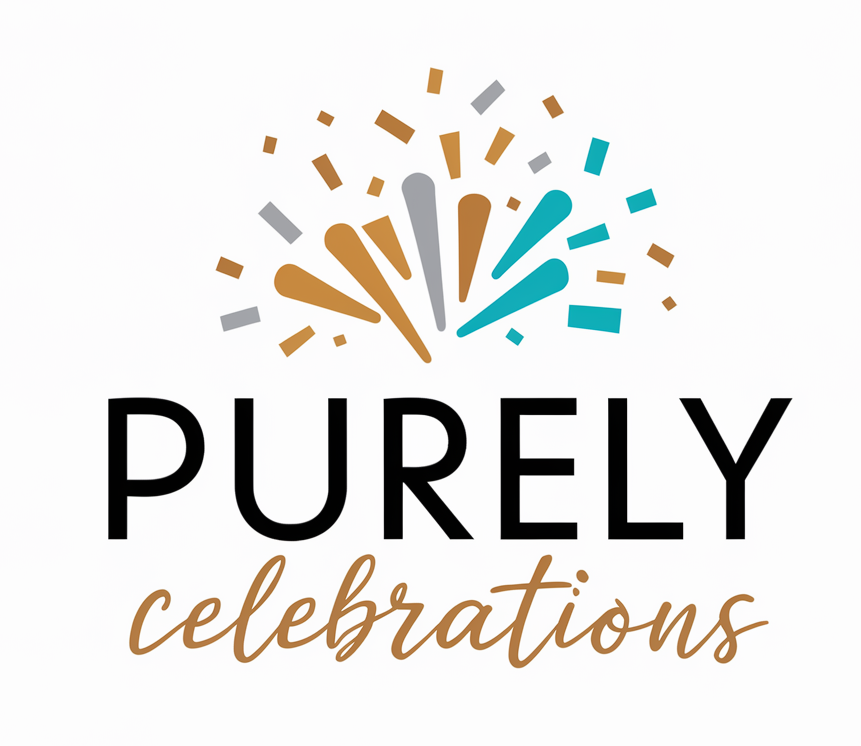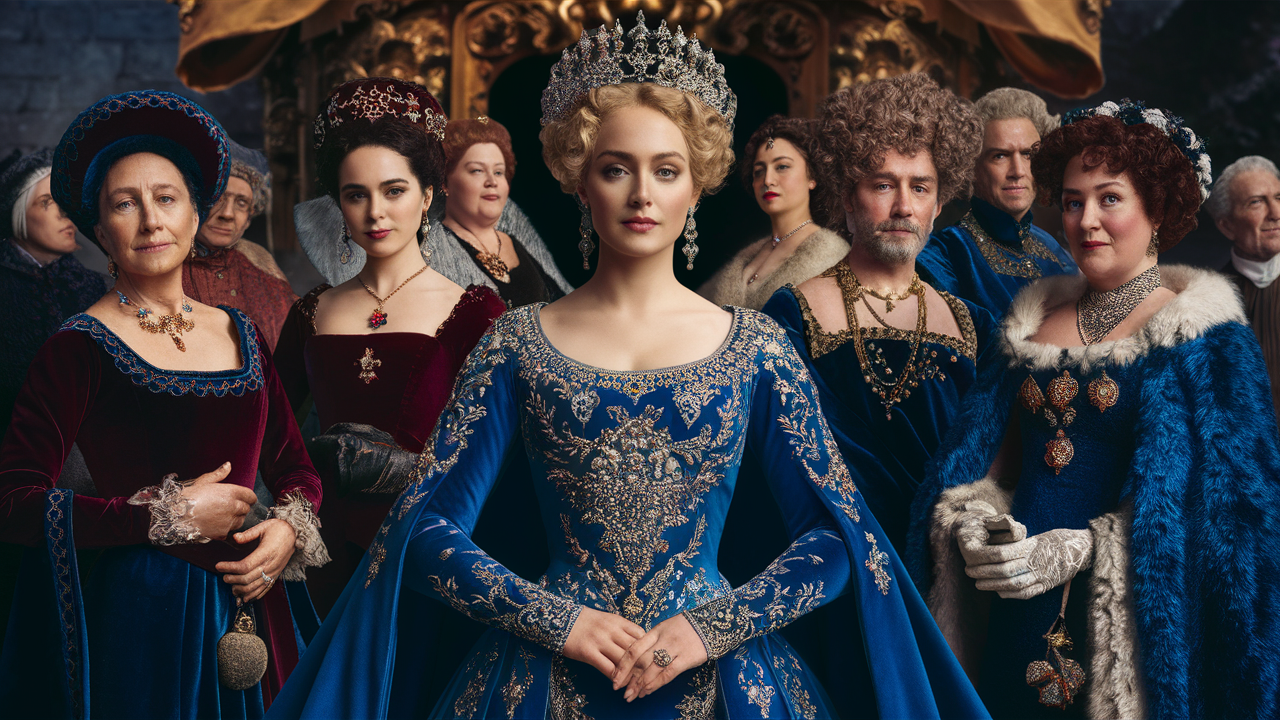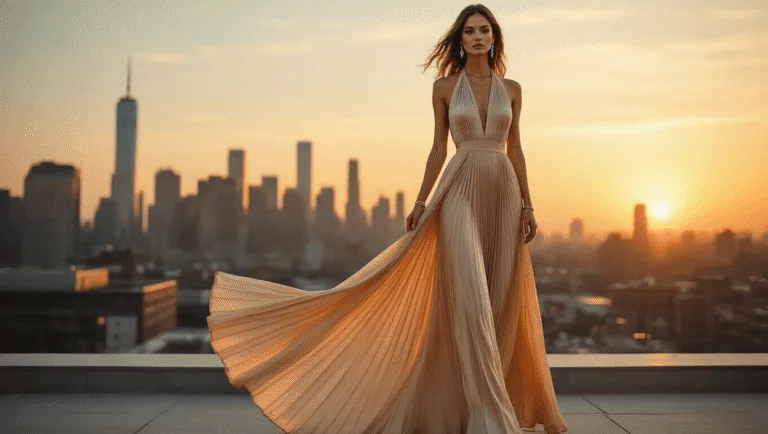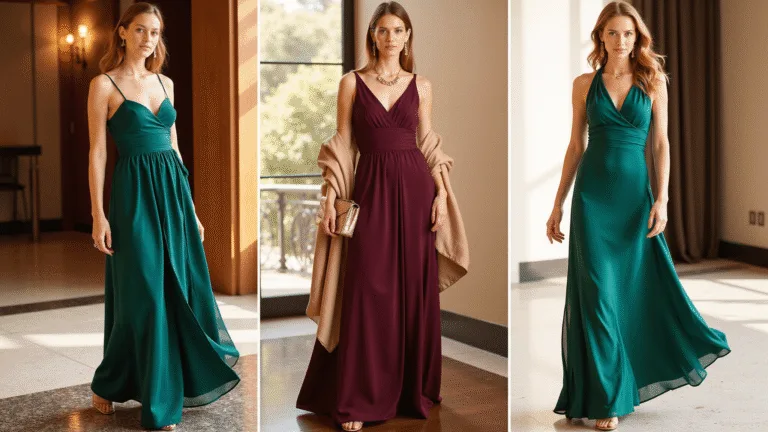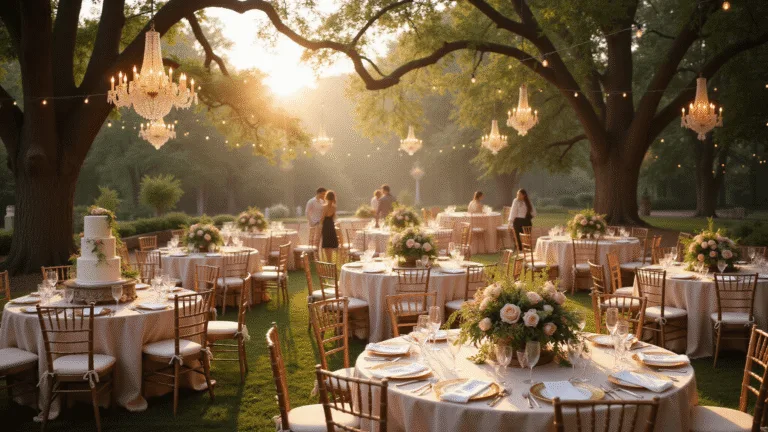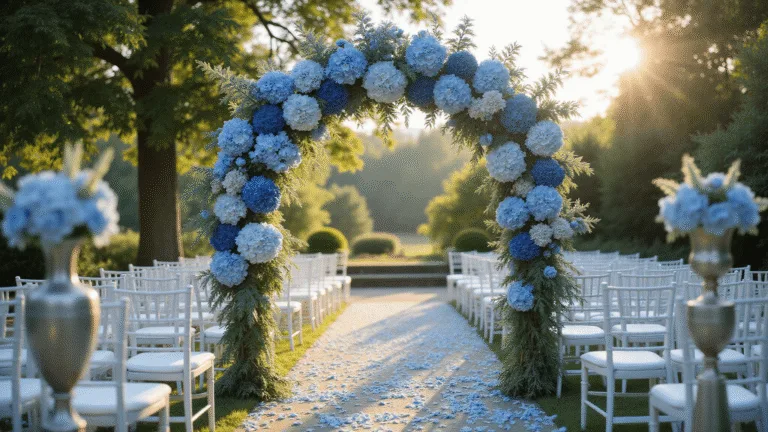15 Stunning Blue Medieval Dresses for Your Next Event
The “Blue Medieval Dress” captures the charm of a bygone era with its rich fabric and stunning design. Perfect for themed events, Renaissance fairs, or just a unique wardrobe addition, this dress combines comfort with striking style. Whether you’re channeling your inner noble or just want to stand out, this piece is sure to make a statement.
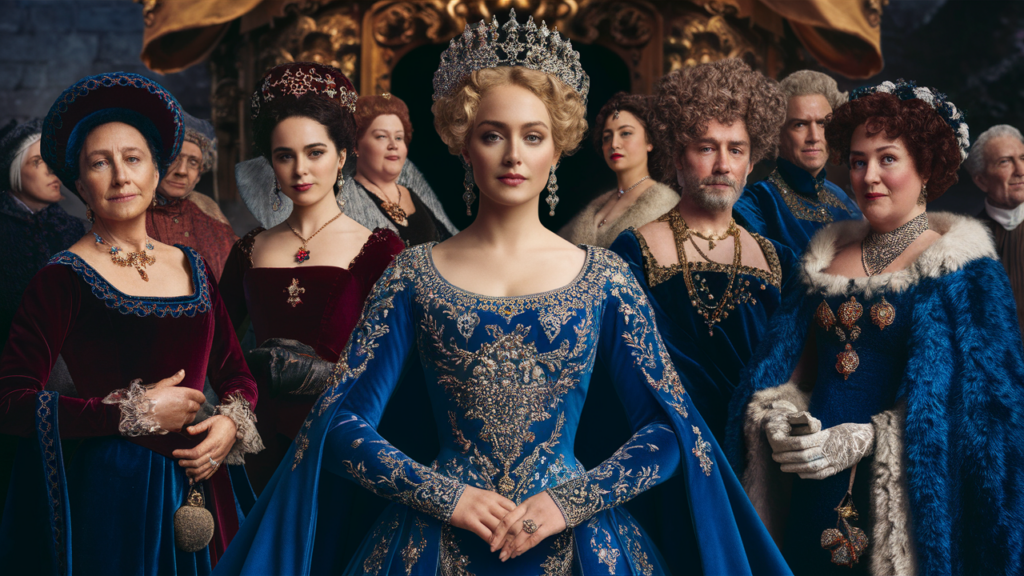
Variations of Blue Fabrics in the Middle Ages
Contents
- Variations of Blue Fabrics in the Middle Ages
- Historical Significance of Blue in Medieval Fashion
- Famous Portraits Featuring Blue Medieval Dresses
- Blue Dye Techniques in Medieval Times
- The Role of Blue in Signifying Status
- Accessorizing a Blue Medieval Dress
- Blue Dresses in Medieval Literature
- Festivals and Celebrations Featuring Blue Attire
- Regional Differences in Blue Dress Styles
- The Influence of Christianity on Blue Fashion Choices
- Evolution of Blue Dress Styles Through the Centuries
- Patterns and Designs Commonly Found on Blue Dresses
- Cultural Symbolism of the Color Blue
- Influence of Royalty on Blue Dress Trends
- Modern Interpretations of Blue Medieval Dresses
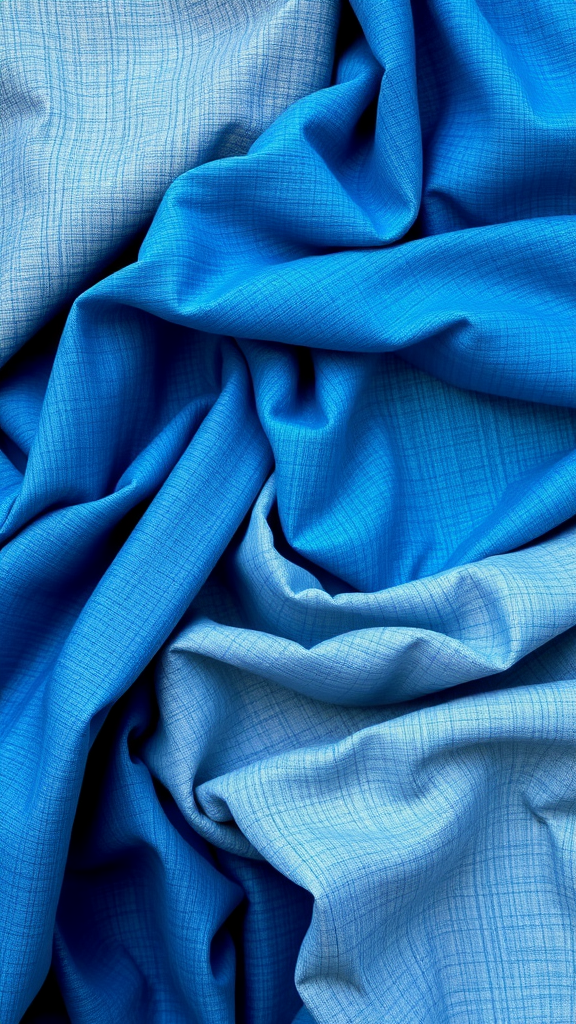
The image shows a variety of blue fabrics, each with its own unique texture and shade. These fabrics reflect a period where blue was a prized color, often associated with wealth and status. In the Middle Ages, the process of creating blue dyes was complex and labor-intensive, making blue textiles highly sought after.
Blue medieval dresses were particularly popular among nobility. The rich tones seen in this image highlight how blue fabrics could transform clothing into statements of power and elegance. Different shades of blue could signify different ranks or regions, adding another layer of meaning to the garments.
Fabrics were often layered and combined, creating stunning visual effects. The way these blue textiles drape in the image reminds us of the craftsmanship involved in medieval dressmaking. Each piece tells a story of artistry and social significance that defined the era’s fashion.
Historical Significance of Blue in Medieval Fashion
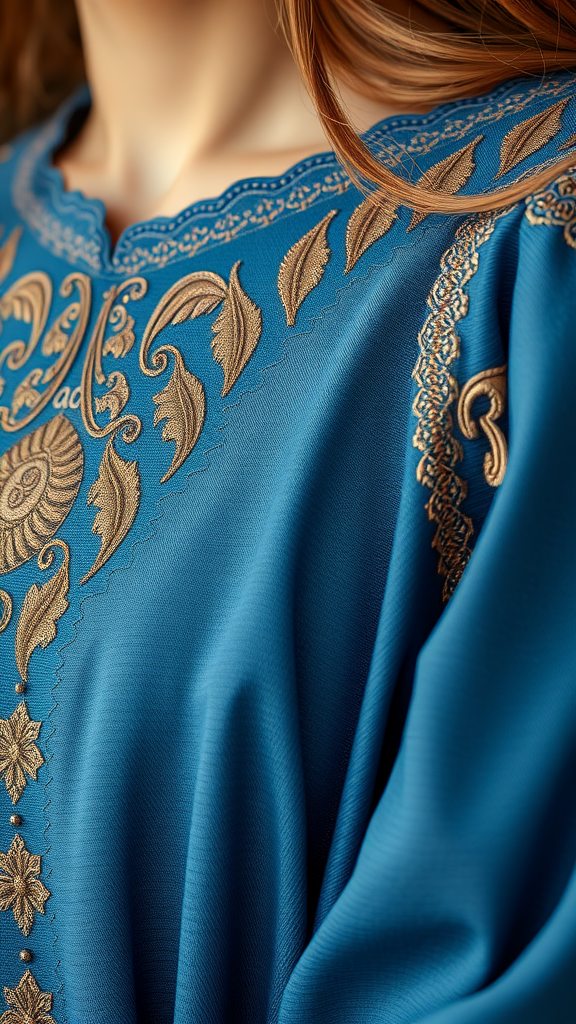
The striking blue medieval dress captured in the image showcases the vibrant hues often favored in medieval attire. Blue was not just a color; it held considerable significance during this period. It represented nobility and was commonly worn by the wealthy.
The intricate gold embroidery enhances the beauty of the dress, making it even more remarkable. This combination of blue and gold was especially popular among the elite, as it symbolized both wealth and status.
During the medieval era, dyes were difficult to produce, making blue fabrics rare and valuable. The presence of such garments indicated the wearer’s high social rank. The craftsmanship displayed in the embroidery reflects the skills of the artisans of the time.
In the wider context of fashion history, the blue medieval dress serves as a reminder of how colors can convey messages about identity and societal roles. Wearing blue was a statement, marking individuals as part of the upper class.
Famous Portraits Featuring Blue Medieval Dresses

The image captures a stunning portrait of a woman dressed in a blue medieval dress. This type of dress is characterized by its rich hue and elegant design, making it a popular choice in medieval art.
The dress features intricate details, such as golden embroidery and a flowing silhouette. The striking blue color stands out beautifully against the subtle backdrop, drawing the viewer’s attention to the subject.
Accessories like the red sash and delicate jewelry add a touch of elegance. The overall presentation highlights the importance of fashion in medieval society, showcasing how clothing reflected social status and cultural identity.
In many portraits from this era, the blue medieval dress symbolizes nobility and grace. Such attire often tells a story about the individual portrayed and the artistic styles of the time.
Blue Dye Techniques in Medieval Times
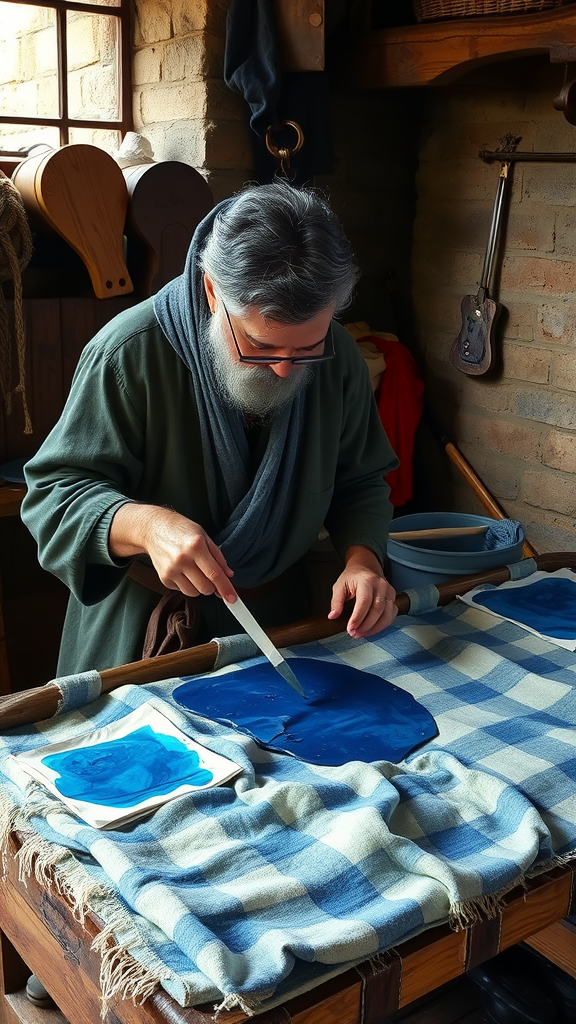
In medieval times, blue dye was a prized color, sought after for its vibrant hue and rarity. The image shows a craftsman carefully preparing the blue dye, showcasing the artistry involved in this process.
The craftsman, dressed in a simple garment, works diligently with a knife on a piece of blue-dyed fabric. The texture and richness of the blue can be seen, hinting at the careful crafting that goes into creating garments like the Blue Medieval Dress. This color was often associated with nobility and was used for clothing that signified status.
Creating blue dye typically involved natural sources, like woad or indigo. These plants were fermented and processed to extract the vivid pigments. The entire process required skill and patience, and the result was clothing that stood out in any crowd.
As you admire the image, think about how these techniques have shaped the way we view color in fashion today. The blue dyeing methods of the past have left a lasting legacy on the textiles we enjoy now.
The Role of Blue in Signifying Status
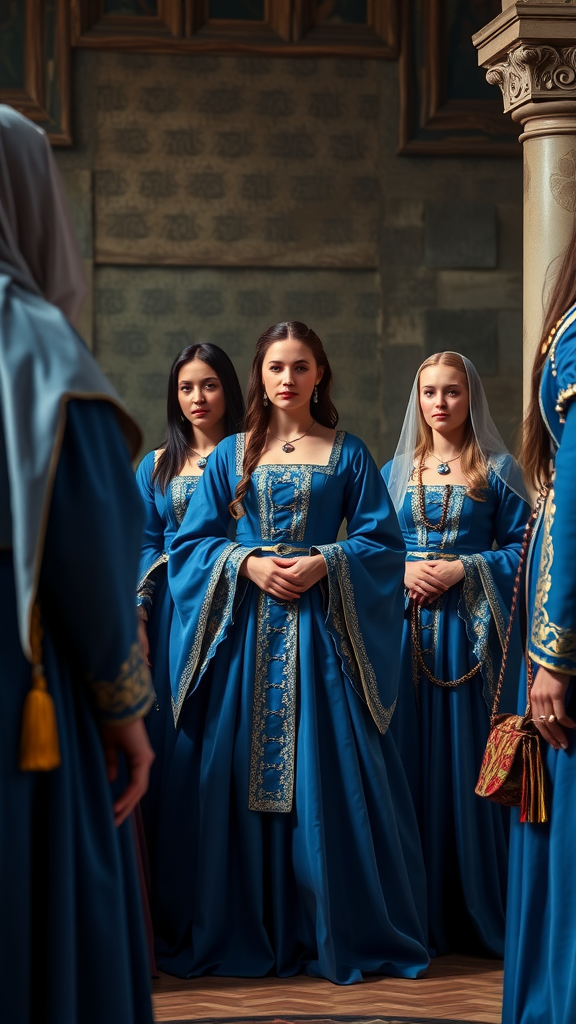
The image showcases a group of women dressed in beautiful Blue Medieval Dresses, each adorned with intricate details. These dresses not only highlight the elegance of the fabric but also the social status of the wearers during medieval times.
In that era, blue was a color often reserved for royalty and the wealthy. The rich hues of blue in their attire represented power and prestige. Such garments would have been costly to make, requiring skilled craftsmanship and expensive dyes.
The setting also enhances the significance of their attire. The backdrop hints at a historical context, likely a gathering place for nobility. The women’s serious expressions reflect the importance of the occasion, showing how clothing played a vital role in social hierarchy.
By choosing blue, these women not only embraced a fashionable choice but also communicated their high status to those around them. This image serves as a reminder of how color can convey much more than just aesthetic appeal.
Accessorizing a Blue Medieval Dress

Accessorizing a blue medieval dress can elevate the entire look. The rich hue of the dress creates a stunning canvas for various accents. Think of adding gold or silver jewelry that complements the fabric’s color.
In the image, the model wears a beautifully detailed blue dress with intricate accents. The belt is a standout piece, featuring a mix of textures and designs. This adds depth and interest to the outfit. A well-chosen belt can define the waist while bringing in a rustic, medieval vibe.
Layering is also key. The model’s hood adds a touch of authenticity. Pairing the dress with a lightweight shawl can be both practical and stylish, especially for cooler days.
Don’t forget about the jewelry! Simple yet striking pieces, like a pendant or layered necklaces, can draw attention to the neckline. Earrings can also add a touch of flair without overwhelming the overall look.
Accessorizing is all about balance. With a blue medieval dress, aim for pieces that enhance its beauty rather than compete with it. The right accessories can transform your look while staying true to the medieval theme.
Blue Dresses in Medieval Literature
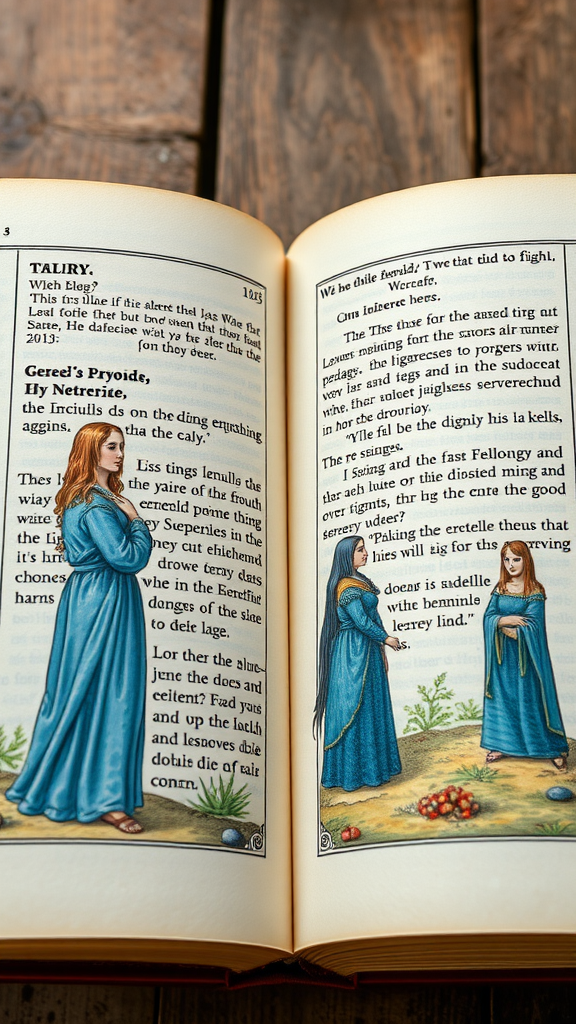
The image showcases a beautifully illustrated book page featuring two women in stunning blue medieval dresses. These garments often symbolize purity, nobility, and sometimes melancholy in medieval narratives.
The blue medieval dress is not just a fashion statement; it often carries deep meaning in literature. In many tales, characters adorned in blue are portrayed as noble or virtuous, reflecting their roles in the stories.
Medieval literature frequently uses colors to convey emotions and traits. Blue, in particular, stands out as a color associated with both the divine and the earthly. It bridges the gap between the spiritual and the material, making it a favorite choice for protagonists.
As we see in the image, the intricate details of these dresses often highlight the craftsmanship of the time. The flowing fabric and rich color invite us to explore the lives of these characters and the stories they inhabit.
Festivals and Celebrations Featuring Blue Attire
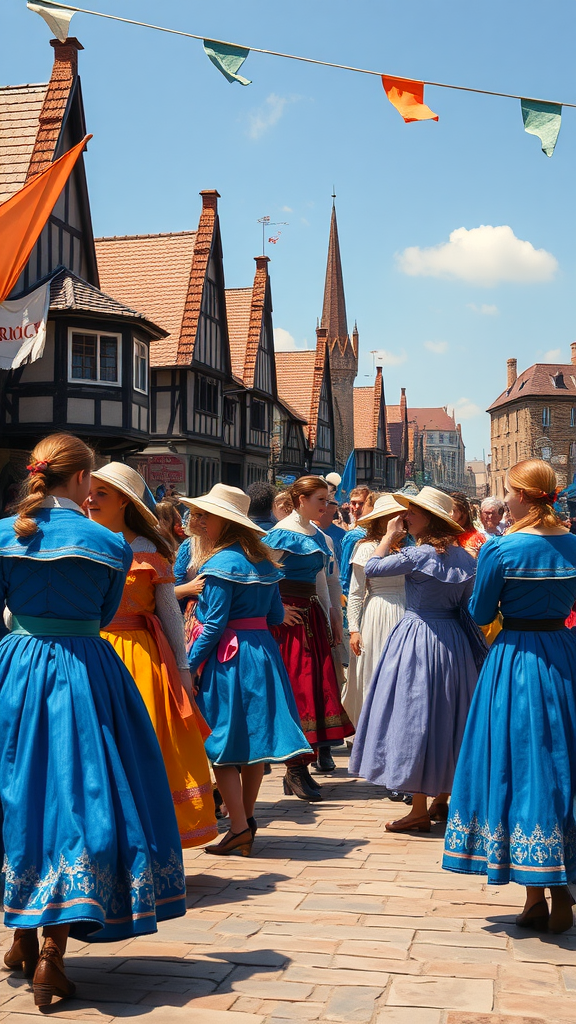
Festivals are full of color and energy, and one of the standout hues seen at many celebrations is blue. This image captures a vibrant scene where participants wear beautiful blue medieval dresses. The flowing skirts and detailed designs add charm to the festivities.
In many cultures, blue attire symbolizes peace and harmony. During celebrations, wearing a blue medieval dress not only showcases tradition but also brings a sense of community. People gather, dance, and enjoy each other’s company, all while dressed in stunning blue outfits.
These festivals often take place in picturesque settings, like the charming streets shown in the image. The backdrop of historical buildings and colorful banners amplifies the festive atmosphere. Each celebration is a reminder of cultural heritage, bringing together people of all ages.
Regional Differences in Blue Dress Styles
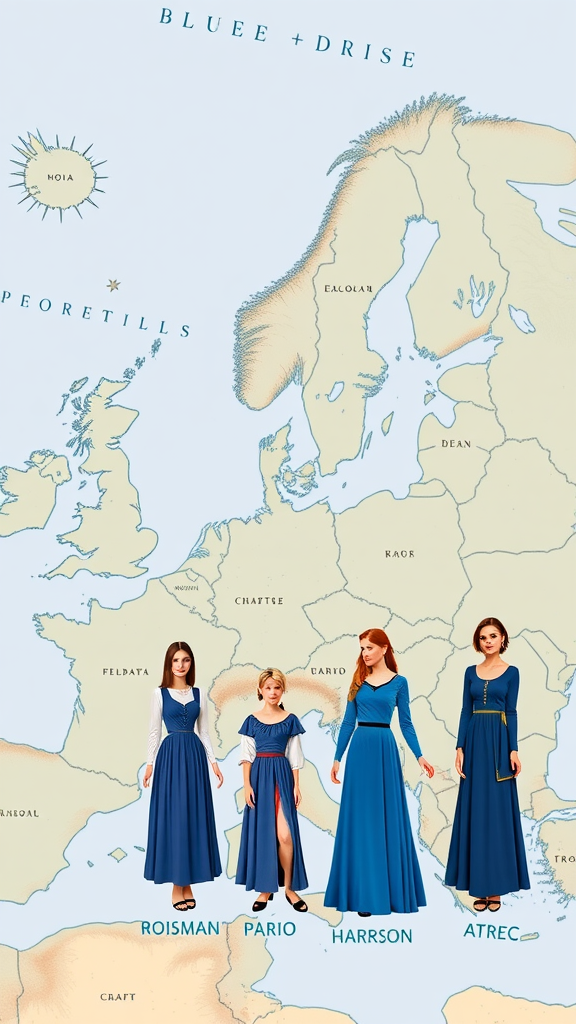
The blue medieval dress comes in various styles across different regions. In the image, we can see four distinct designs, each reflecting the fashion influences of its area. These dresses are not just about color; they tell a story of culture and tradition.
Starting from the left, the dress from Roisman features classic lines and a layered look. It’s both stylish and practical, perfect for everyday wear. Next is the charming design from Pario. This one has a playful vibe, with a shorter hemline that hints at youthful energy.
Moving on to Harrson, the dress showcases a more formal style. Its sleek silhouette and elegant neckline highlight sophistication, making it suitable for special occasions. Lastly, the dress from Atrec leans towards a contemporary twist on medieval fashion, with a fitted design and striking details.
These dresses represent the regional flair that defines the blue medieval dress style. Each piece is a celebration of local craftsmanship and fashion sensibilities, making them unique yet part of a larger tradition.
The Influence of Christianity on Blue Fashion Choices

The image showcases a group of individuals dressed in stunning blue robes, creating a striking contrast against the intricate stained glass backdrop. This scene likely takes place in a church or cathedral, which adds a sacred atmosphere to their attire.
Historically, blue has held significant meaning in Christianity. It often symbolizes heaven, spirituality, and divine grace. The choice of a Blue Medieval Dress is not just about fashion; it reflects deeper themes of faith and devotion.
In many religious settings, colors play an important role in conveying messages. Blue is frequently associated with the Virgin Mary, reinforcing its spiritual significance. Those wearing blue in church can be seen as embodying purity and loyalty, aligning themselves with these profound ideals.
As we observe this group, we can appreciate how fashion choices, like the Blue Medieval Dress, can serve as a visual expression of faith and community. The robes symbolize unity and shared beliefs, creating a beautiful harmony in their worship.
Evolution of Blue Dress Styles Through the Centuries
The timeline of blue dress styles highlights a fascinating journey through fashion history. Each dress in the image represents a distinct era, showcasing how styles have evolved over time. Starting from the 21st century, we see the earliest designs, which were simple yet elegant.
The Blue Medieval Dress captures the essence of craftsmanship and artistic expression. This particular style reflects the materials and techniques of its time, emphasizing the beauty of deep blue hues. As we move through the timeline, details like patterns and cuts start to change, revealing what was popular in different periods.
For instance, the dresses like those from the year 2071 feature more intricate designs, showcasing the skill of the makers. By contrasting these styles, we can appreciate how cultural influences and societal norms shaped clothing choices. The current styles, seen in the latest designs from 2025, incorporate modern elements that still pay homage to historical roots.
Patterns and Designs Commonly Found on Blue Dresses
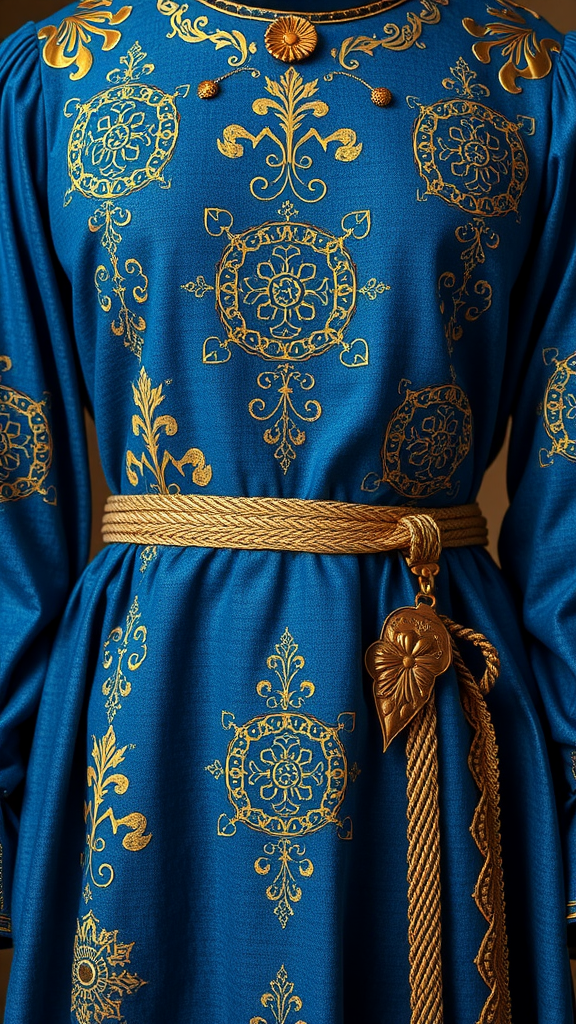
The image showcases a stunning blue medieval dress that beautifully illustrates the elegance of pattern and design. The rich blue fabric is adorned with intricate golden motifs that create a striking contrast. Each design element seems to tell its own story, drawing us into a world of historical fashion.
The golden patterns include floral and circular shapes, typical of medieval artistry. These designs not only enhance the dress’s aesthetic appeal but also reflect the craftsmanship of the era. The delicate details are accentuated by the way the fabric catches the light, giving it a regal appearance.
The dress is cinched at the waist with a golden braided belt, adding definition and style. This belt complements the ornate designs on the dress, making it a perfect example of how accessories can elevate a garment. The combination of blue and gold is timeless and continues to inspire modern fashion.
For those looking to embrace the charm of vintage fashion, a blue medieval dress like this one offers a unique style statement. Its patterns and designs make it suitable for various occasions, from themed events to casual gatherings. It is a beautiful reminder of the artistry in clothing.
Cultural Symbolism of the Color Blue
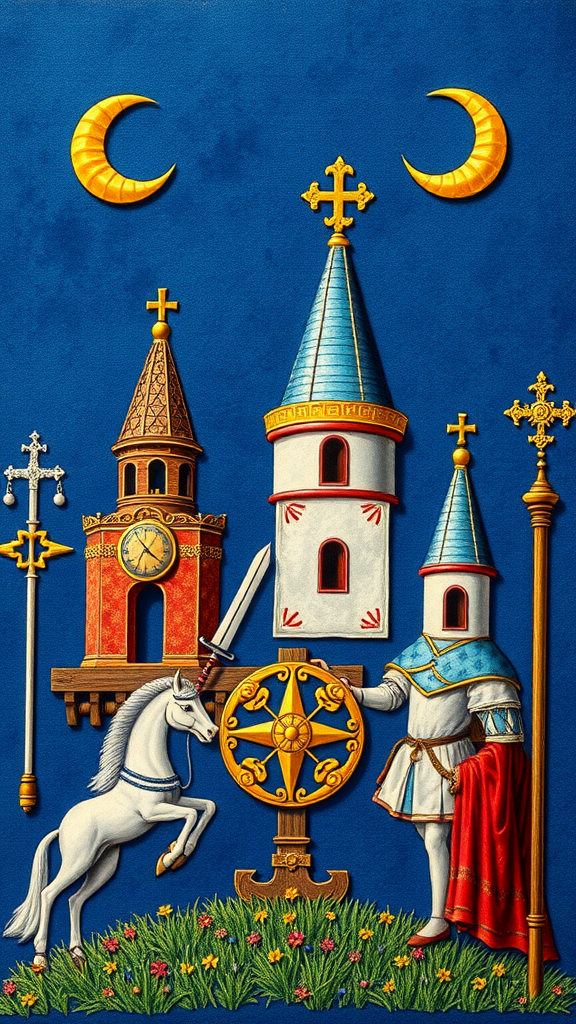
The color blue has deep roots in cultural symbolism. It evokes feelings of calmness and serenity while also representing trust and loyalty. In many societies, blue is linked to spirituality and protection. This vibrant hue often appears in religious art and architecture, showcasing its significance across cultures.
In the image, we see elements that reflect medieval culture. The blue background creates a striking contrast with the vibrant details, like the towers and the knight. The blue medieval dress worn by the knight signifies nobility and virtue. This connection to royalty elevates the color’s status, presenting it as a symbol of honor.
The unicorn, often associated with purity and grace, further enhances the blue’s meaning. Together with the towers, the knight, and the celestial symbols, the blue color threads a rich narrative of valor and spiritual depth. It invites us to reflect on its importance in storytelling through art and history.
Influence of Royalty on Blue Dress Trends
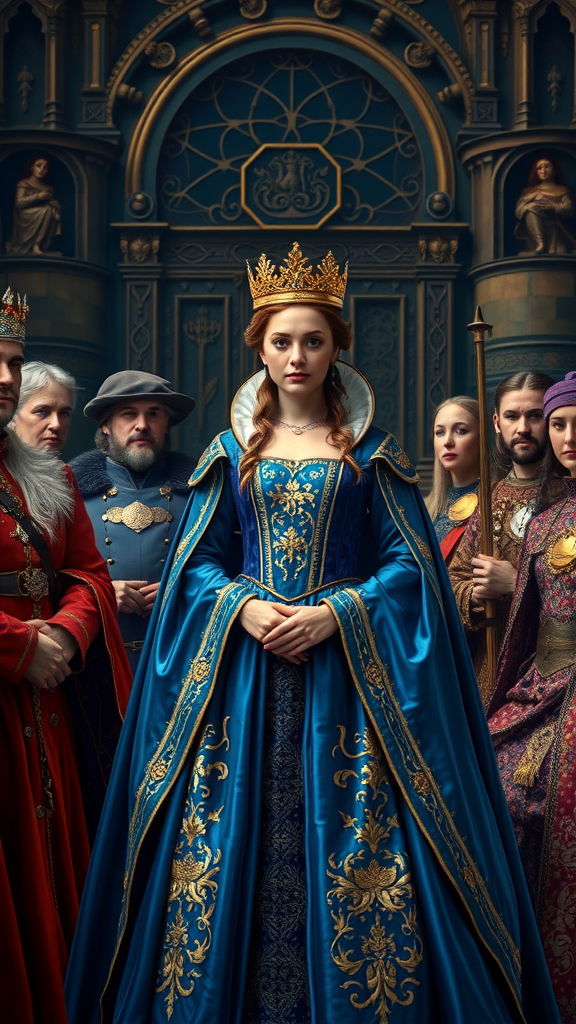
The image captures a stunning scene that showcases the influence of royalty on fashion, particularly the allure of the blue medieval dress. The central figure, adorned in a magnificent blue gown embellished with intricate gold designs, exemplifies regal elegance. Her majestic crown adds to the royal vibe, making her the focal point of the group.
Surrounding her are other characters dressed in richly colored attire, each contributing to the grandeur of the setting. The background hints at an elaborate castle or palace, enhancing the sense of nobility. This imagery reflects how royal figures often set trends that resonate through time.
The blue medieval dress, in particular, has become iconic, symbolizing not just fashion but a sense of grace and authority. It inspires designers and influencers today, emphasizing the lasting impact royalty has on clothing trends.
Overall, this image serves as a beautiful reminder of the connection between royals and fashion, especially through the timeless blue dress that continues to inspire modern styles.
Modern Interpretations of Blue Medieval Dresses
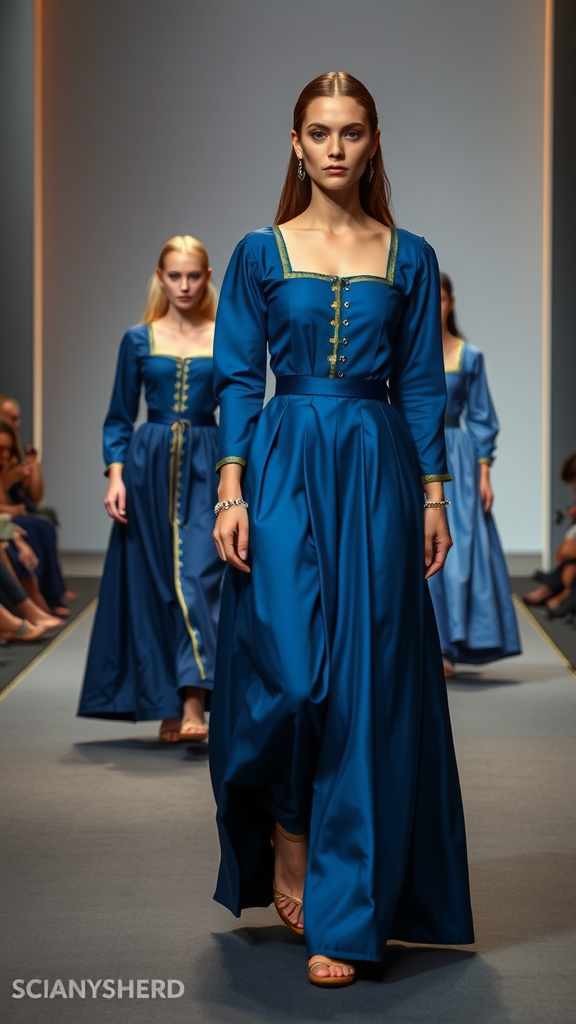
The image captures a striking runway scene featuring models in stunning blue medieval dresses. These outfits bring a fresh take on traditional styles, highlighting both elegance and contemporary fashion trends.
The deep blue fabric of the dresses is rich and eye-catching, reminiscent of the colors often used in medieval attire. Each dress has been tailored to enhance the figure, while still paying homage to the flowing silhouettes of the past.
Design elements like the square neckline and button details reflect historical styles, while the overall fit and finish showcase modern craftsmanship. The models’ confident poses add a dynamic touch to the presentation, making the dresses feel both timeless and relevant.
This blend of old and new is what makes blue medieval dresses so captivating today. They serve as a perfect example of how historical fashion can inspire current trends, merging tradition with innovation in a stylish way.
